Welcome to the Nikon D70s Owners Manual, your comprehensive guide to understanding and mastering your camera․ This manual provides detailed insights into the camera’s features, settings, and troubleshooting, helping you unlock its full potential for exceptional photography․
Brief History and Overview of the Nikon D70s
The Nikon D70s, released in 2005, is an enhanced version of the D70, offering improved features and performance․ It features a 6-megapixel CCD sensor, 5-area autofocus, and a robust build quality․ Designed for enthusiasts and professionals, it supports RAW image capture and various shooting modes․ The D70s was praised for its balance of functionality and affordability, making it a popular choice in its era․ It laid the groundwork for future Nikon DSLRs, including the D80, and remains a beloved camera among photography enthusiasts․
Importance of Reading the Manual
Reading the Nikon D70s owner’s manual is essential to fully understanding and utilizing your camera’s capabilities․ It provides detailed explanations of features, settings, and troubleshooting tips, ensuring you get the most out of your photography․ The manual helps you master shooting modes, customize controls, and maintain your camera properly․ By familiarizing yourself with the guide, you can optimize your settings, resolve common issues, and enhance your overall photography experience․ It serves as a valuable resource for both beginners and advanced users, unlocking the camera’s full potential․
Key Features of the Nikon D70s
The Nikon D70s boasts a 6․1-megapixel DX-format sensor, offering sharp and detailed images․ It features a 5-area autofocus system for precise subject tracking and 3D Color Matrix Metering II for accurate exposure control․ The camera supports RAW file capture and has a robust burst mode for capturing action shots․ Additionally, it includes an intuitive LCD screen for reviewing images and accessing menu settings․ With compatibility with Nikon’s extensive range of lenses and accessories, the D70s is a versatile tool for photographers seeking high-quality results in various shooting conditions․
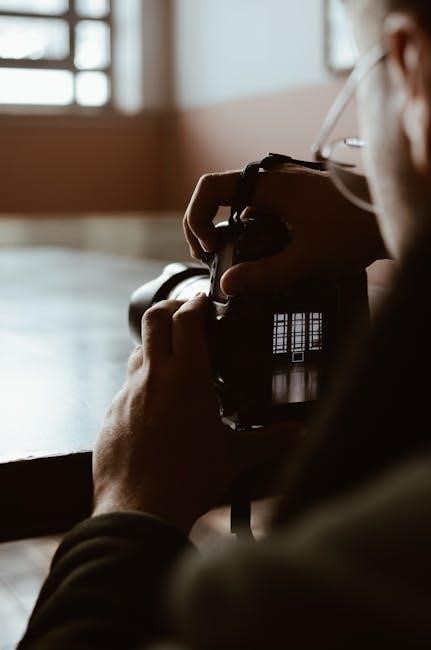
Key Components and Controls
The Nikon D70s features a user-friendly interface with essential buttons, mode dials, and an LCD screen․ Its design ensures intuitive access to settings, optimizing photographic workflows efficiently․
Front Controls: Buttons and Functions
The front of the Nikon D70s features a range of essential controls designed for quick access during shooting․ The focus mode lever, located near the lens mount, allows switching between AF (autofocus) and M (manual focus) modes․ The function button, labeled FUNC, provides shortcuts to frequently used settings like ISO sensitivity․ Additionally, the BKT button enables bracketing for capturing multiple exposures at different settings, while the flash button activates the built-in flash or external flash units․ These controls streamline workflow, ensuring intuitive operation for photographers of all skill levels;
Top Controls: Mode Dial and Shooting Modes
The top of the Nikon D70s features a mode dial that allows quick access to various shooting modes․ These include Auto Mode for point-and-shoot simplicity, Program Mode for balanced aperture and shutter settings, Aperture Priority for manual aperture control, Shutter Priority for manual shutter control, and Manual Mode for full control over both aperture and shutter speed․ Additionally, the dial includes settings for Custom Shooting Modes, enabling users to save personalized configurations․ The mode dial is complemented by a B (bulb) mode for long exposures, offering flexibility for diverse photography needs․
Rear Controls: LCD Screen and Navigation
The rear of the Nikon D70s features a 2-inch LCD screen for reviewing images and accessing menu settings․ Below the screen, the multi-selector allows for easy navigation of menus and selection of autofocus points․ The OK button confirms settings, while the Playback button toggles image review․ Additional buttons include Menu for accessing camera settings and Erase for deleting images․ These controls provide intuitive access to the camera’s features, making it easy to adjust settings and review your work on the go․

Setting Up Your Nikon D70s
Mastering the Nikon D70s begins with proper setup․ Ensure firmware is updated, install memory cards, and configure basic settings like date, time, and language for optimal performance․
Initial Setup and First-Time Use
Before using your Nikon D70s, ensure the battery is fully charged and inserted correctly․ Install a memory card, preferably formatted in the camera․ Power on the camera and navigate through the initial setup menu to set language, date, and time․ Review and update firmware if necessary․ Familiarize yourself with basic controls, such as the mode dial and autofocus/manual focus switch․ Experiment with default settings to understand functionality․ Refer to the manual for detailed guidance on customization and optimal first-use configurations to enhance your photography experience immediately․
Updating Firmware and Software
To ensure optimal performance, regularly update your Nikon D70s firmware and software․ Visit Nikon’s official website to download the latest firmware version compatible with your camera․ Use a memory card to transfer the update to your camera․ Insert the card, navigate to the firmware update option in the menu, and follow on-screen instructions․ Avoid interrupting the update process to prevent potential damage․ After completion, restart your camera to apply the changes․ This ensures you have the latest features, bug fixes, and performance enhancements for improved functionality and photography results․
Memory Card Installation and Management
For the Nikon D70s, insert a CompactFlash (CF) card into the memory card slot located on the camera’s side․ Ensure the card is fully seated and the write-protect tab is not engaged․ Format the card using the camera’s menu to optimize performance․ Use high-speed CF cards for better data transfer rates․ Avoid filling the card beyond 80-90% capacity for efficient writing․ After shooting, transfer images to a computer and organize them․ Always handle cards with care to prevent damage and data loss․ Regular formatting helps maintain card reliability and camera functionality․

Shooting Modes and Settings
The Nikon D70s offers versatile shooting modes, including Auto, Manual, Aperture Priority, Shutter Priority, and Program Mode․ These modes provide flexibility for photographers of all skill levels, ensuring optimal control over settings like aperture, shutter speed, and exposure compensation․ Customizable profiles and scene-specific adjustments further enhance creativity and precision in various shooting conditions․
Auto Mode: Point-and-Shoot Photography
Auto Mode simplifies photography, letting the camera handle settings for quick, hassle-free shots․ Ideal for beginners, it optimizes exposure, focus, and ISO automatically․ The camera selects the best settings for the scene, ensuring sharp, well-lit images with minimal effort․ Use Auto Mode for casual shooting or when you need fast results without manual adjustments․ It’s perfect for capturing spontaneous moments, portraits, or everyday scenes, delivering reliable results with ease․ This mode is a great starting point for new photographers to explore before moving to manual controls․
Manual Mode: Full Control Over Settings
Manual Mode offers full control over camera settings, allowing photographers to customize aperture, shutter speed, and ISO for precise results․ Access Manual Mode via the mode dial (M)․ This mode is ideal for creative control, enabling adjustments to suit specific lighting conditions or artistic goals․ Use the command dial to adjust aperture and shutter speed independently․ Manual Mode is perfect for experienced photographers seeking ultimate control over their images․ Refer to the manual for detailed guidance on fine-tuning these settings to achieve professional-quality photos․
Aperture Priority and Shutter Priority Modes
Aperture Priority (A/Av) and Shutter Priority (S/Tv) modes provide semi-automatic control, blending creativity with ease․ In Aperture Priority, set the aperture to control depth of field, while the camera adjusts shutter speed․ Ideal for portraits and landscapes․ Shutter Priority lets you set shutter speed to capture motion or freeze action, with the camera adjusting aperture․ Both modes are accessible via the mode dial and offer flexibility for photographers who want to balance automation with manual adjustments, ensuring optimal results in various lighting scenarios․
Program Mode: Balancing Aperture and Shutter Speed
Program Mode (P) offers a balanced approach, automatically setting aperture and shutter speed for optimal exposure while allowing adjustments․ Ideal for versatile shooting, it adapts to lighting conditions, ensuring sharp images with proper depth of field․ Accessible via the mode dial, Program Mode is perfect for photographers who want automatic settings with the flexibility to fine-tune results․ It provides a great middle ground between manual control and ease of use, making it suitable for various photography scenarios without compromising image quality․
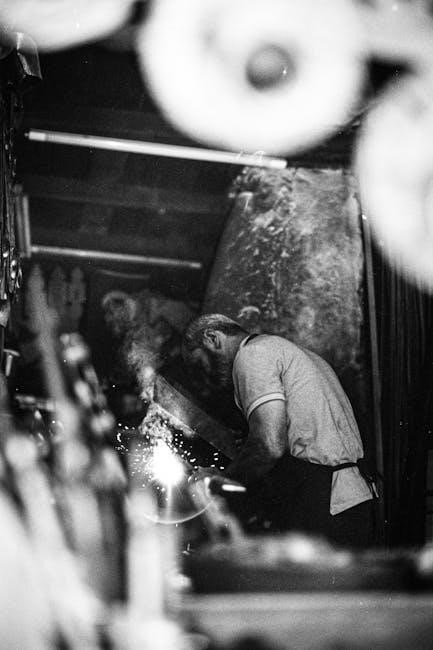
Focus and Metering
This section covers the Nikon D70s’ focus and metering systems, explaining autofocus modes, manual focus operation, and metering options for precise exposure control, enhancing your photography․
Understanding Autofocus Modes
The Nikon D70s features advanced autofocus modes to suit various shooting scenarios․ Single AF (AF-S) locks focus on stationary subjects, ideal for portraits and stills․ Continuous AF (AF-C) tracks moving subjects, perfect for action photography․ The Auto AF mode allows the camera to switch between AF-S and AF-C based on subject movement․ These modes ensure sharp images by adapting to your creative needs, whether capturing fleeting moments or precise details․ Mastering these settings enhances your ability to achieve professional-grade results in diverse photographic situations․
Manual Focus: When and How to Use It
Manual focus on the Nikon D70s provides precise control over focusing, ideal for situations where autofocus may struggle, such as low-light conditions or when shooting stationary subjects․ To use manual focus, switch the focus mode lever on the lens to “M․” Adjust the focus ring while monitoring the LCD screen or viewfinder for sharpness․ This method is particularly useful for macro photography, portraits, or when you want creative control over the focal point․ Mastering manual focus enhances your ability to capture images with exacting detail and clarity․
Metering Modes: Matrix, Center-Weighted, and Spot
The Nikon D70s offers three metering modes to adapt to various lighting conditions․ Matrix metering analyzes the entire scene for balanced exposure, ideal for everyday shooting․ Center-Weighted metering prioritizes the central area, useful for portraits․ Spot metering measures light from a small area, perfect for high-contrast scenes or precise subject exposure․ Understanding these modes allows you to capture images with accurate lighting and detail, enhancing your creative control over exposure settings․

Custom Settings and Personalization
Customize your Nikon D70s to suit your photography style by adjusting controls, creating profiles, and configuring settings for personalized shooting experiences and enhanced creative control․
Customizing Camera Controls
Customizing your Nikon D70s camera controls allows you to tailor the camera to your shooting style․ Assign functions to buttons like AE-L/AF-L and FUNC for quick access․ Use the Custom Settings menu to adjust autofocus modes, metering, and exposure settings․ Personalize the camera’s behavior for auto/manual focus, bracketing, and flash control․ This customization enhances your workflow, making it easier to capture shots efficiently․ By tailoring controls, you can streamline your photography process and improve overall performance, ensuring a more intuitive and enjoyable shooting experience․
Creating and Saving Custom Shooting Profiles
Custom shooting profiles on the Nikon D70s allow you to save personalized camera settings for specific photography scenarios․ Access the Custom Settings menu to adjust ISO, white balance, and autofocus modes․ Once configured, save these settings as a profile using the “Save/Load Settings” option․ Name and store up to four profiles for quick recall․ This feature streamlines your workflow, enabling rapid adjustments for different shooting conditions․ Saved profiles are stored in the camera’s memory, ensuring your preferred settings are always accessible for consistent results․
Configuring the Camera for Specific Shooting Styles
The Nikon D70s allows you to tailor settings to specific shooting styles, ensuring optimal results․ For portraits, use lower ISO and softer focus modes․ Landscape photography benefits from wide-angle lenses and manual white balance․ Sports require fast shutter speeds and continuous autofocus․ Night photography demands higher ISO and noise reduction․ Each style has unique demands, and the D70s offers customization to meet them․ Experiment with these configurations to enhance your photography and achieve professional-quality images consistently․
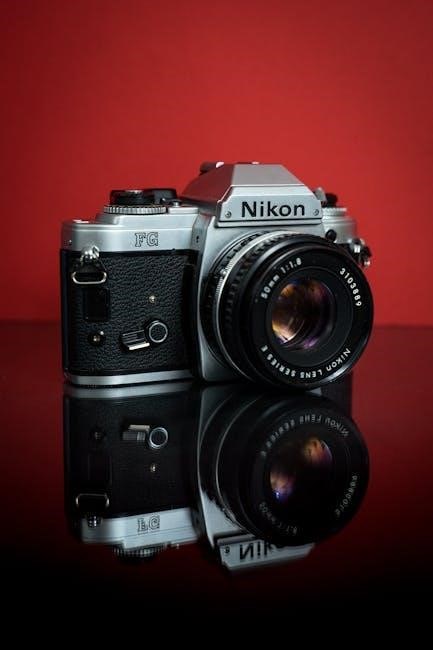
Flash and External Lighting
The Nikon D70s features a built-in flash for convenient lighting․ External flash units can be connected for enhanced illumination․ Wireless flash photography is also supported, offering flexibility․
Using the Built-in Flash
The Nikon D70s features a built-in flash for added illumination in low-light conditions․ To activate it, press the flash button on the front of the camera․ The flash automatically pops up and fires when needed․ It offers modes like Auto, Fill, and Slow Sync, allowing for creative control over lighting․ Manual power adjustment is also available for precise control․ For portraits, the flash includes a red-eye reduction option to minimize unwanted effects․ Always ensure the flash is clean and free of obstructions for optimal performance․ For more advanced lighting, consider pairing with external flash units․
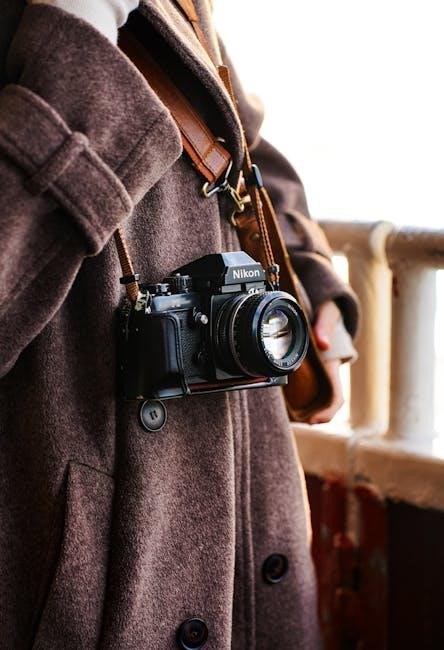
External Flash Units: Compatibility and Setup
For enhanced lighting control, the Nikon D70s supports external flash units like the SB-800 and SB-600․ These flashes are compatible with Nikon’s TTL system, ensuring precise exposure․ To set up, attach the flash to the hot shoe mount on the camera’s top․ Sync settings can be adjusted via the camera’s menu, enabling wireless operation for off-camera flashes․ This feature is ideal for professional photography, allowing for creative lighting setups and improved image quality in challenging environments․ Always ensure compatibility with Nikon’s flash system for optimal performance․
Wireless Flash Photography
Wireless flash photography with the Nikon D70s offers advanced lighting control․ Use the built-in flash as a commander to trigger external units like the SB-600 or SB-800 wirelessly․ Set the external flash to slave mode and ensure line-of-sight communication․ This setup enhances creativity, allowing precise lighting without cables․ Adjust power ratios via the camera menu for balanced illumination․ Wireless flash photography is ideal for dynamic off-camera lighting setups, ensuring professional results in various shooting scenarios․ Proper synchronization ensures consistent exposure, making it a versatile tool for photographers seeking advanced lighting techniques․
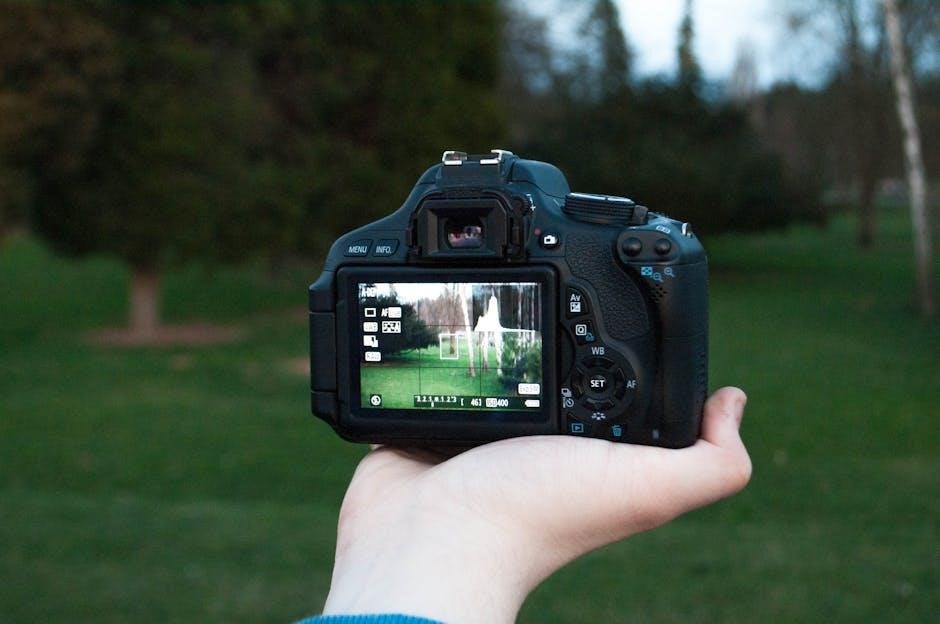
Image Quality and White Balance
The Nikon D70s offers customizable image quality settings, including resolution and compression options, ensuring optimal file size and detail․ White balance presets adapt to lighting conditions, with a custom option for precise color accuracy, enhancing overall image clarity and color reproduction․
Understanding Image Quality Settings
The Nikon D70s offers customizable image quality settings to suit your photography needs․ Choose from resolution options like 3008×2000 pixels for high detail or lower settings for smaller files․ Compression options include Fine, Normal, and Basic, balancing file size and image quality․ Fine mode retains maximum detail, ideal for professional work, while Basic reduces file size for casual use․ These settings allow you to manage storage and workflow efficiently, ensuring your images meet your creative and practical requirements without compromising quality․
White Balance: Presets and Custom Options
White balance ensures accurate color reproduction by adjusting to lighting conditions․ The Nikon D70s offers presets like Auto, Daylight, Fluorescent, Incandescent, and more․ Auto mode automatically adjusts, while presets provide quick corrections․ For precise control, use the custom white balance option by capturing a reference object under the same lighting․ This ensures neutral tones and vibrant colors․ Experiment with these settings to enhance your images and achieve professional results in various lighting scenarios, making your photography more expressive and true-to-life․
Noise Reduction and Image Optimization
Noise reduction on the Nikon D70s minimizes grain in low-light images․ Enable Long Exposure NR for shots taken at slower shutter speeds or High ISO NR to reduce digital artifacts․ These settings help capture cleaner, smoother images․ For image optimization, adjust sharpening, contrast, and color balance to enhance clarity and vibrancy․ Customizing these parameters ensures your photos look their best, whether shooting in RAW or JPEG․ Balancing noise reduction and image optimization is key to achieving professional-quality results in various lighting conditions․
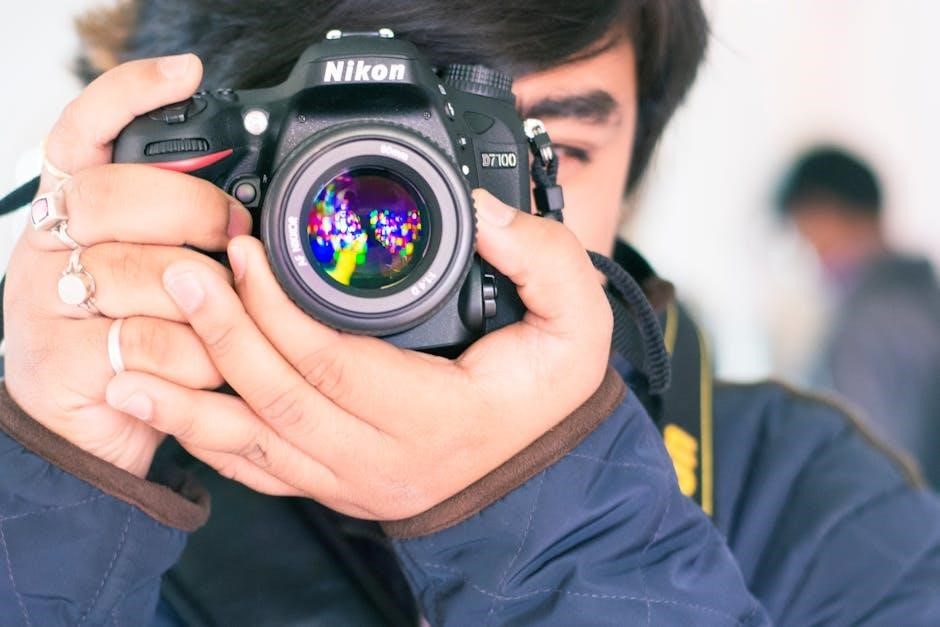
Maintenance and Troubleshooting
Regularly clean the camera sensor and exterior to prevent damage․ Address common issues like error messages or functionality problems․ Resetting to factory settings or updating firmware often resolves these issues․
Cleaning the Camera and Sensor
Regular maintenance ensures optimal performance․ Use a soft, dry cloth to wipe the camera exterior and lens․ For the sensor, activate the camera’s cleaning mode and gently remove dust with a blower bulb․ Avoid touching the sensor surface․ If stubborn spots remain, use a specialized cleaning swab with caution․ Always power off the camera before cleaning․ Refer to the manual for detailed steps to avoid damage․ Cleaning the sensor regularly prevents blurry images and maintains image quality․ If unsure, consult a professional for safe and effective cleaning․
Common Issues and Solutions
Addressing common issues ensures your Nikon D70s performs optimally․ If the camera freezes, restart it by removing the battery and memory card․ For sensor dust, use the cleaning mode and a blower bulb․ If images appear blurry, check autofocus settings or clean the lens․ Memory card errors often resolve by formatting the card in-camera․ For persistent problems, reset the camera to factory settings or update the firmware․ Refer to the manual for detailed troubleshooting steps to resolve issues quickly and maintain peak performance․
Resetting the Camera to Factory Settings
To reset your Nikon D70s to factory settings, press and hold the two buttons marked with green dots—the QUAL and EXPO COMP buttons—while turning the camera on․ This will restore default settings, erasing all custom configurations․ Be sure to reconfigure your preferred settings after the reset․ This process is useful for troubleshooting or preparing the camera for sale․ Refer to the manual for additional details on performing a factory reset and managing camera settings effectively․
Congratulations! You’ve mastered the Nikon D70s․ Keep experimenting, exploring, and capturing stunning images․ Thank you for choosing this guide to enhance your photography journey․
Final Tips for Getting the Most Out of Your Nikon D70s
Maximize your Nikon D70s experience by exploring its advanced features and custom settings․ Regularly update firmware for optimal performance․ Experiment with RAW format for greater post-processing flexibility․ Clean the sensor and camera body to maintain image quality․ Use external flashes and lenses to expand creative possibilities․ Familiarize yourself with manual focus for precise control․ Practice different shooting modes and metering techniques․ Store this manual for quick reference and enjoy capturing stunning photos with your Nikon D70s․
Resources for Further Learning
For deeper exploration, visit Nikon’s official website for downloadable manuals, firmware updates, and software․ Explore user forums and photography communities for tips and experiences․ Check out eBooks and online tutorials for advanced techniques․ Utilize Nikon’s customer support for troubleshooting․ Stay updated with photography blogs and reviews for the latest insights․ These resources will help you refine your skills and make the most of your Nikon D70s․
Nikon Support and Customer Service
Nikon offers comprehensive support for D70s users through their official website, including downloadable manuals, firmware updates, and troubleshooting guides․ Their customer service team is available to assist with technical inquiries and repair services․ Additionally, Nikon-authorized dealers provide reliable maintenance and genuine accessories․ Visit their support portal for FAQs, repair requests, and software downloads, ensuring your D70s operates optimally with professional guidance and resources․
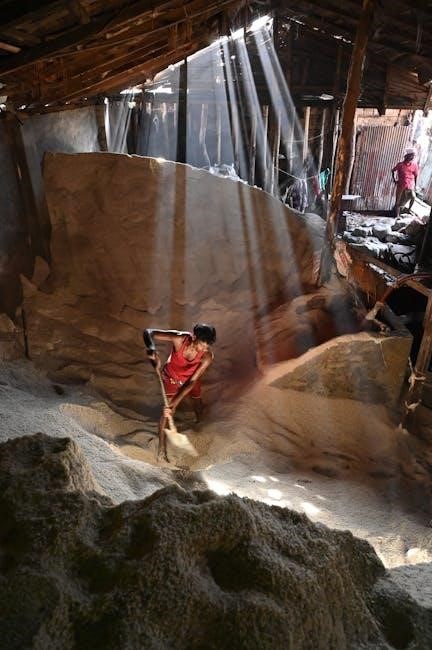

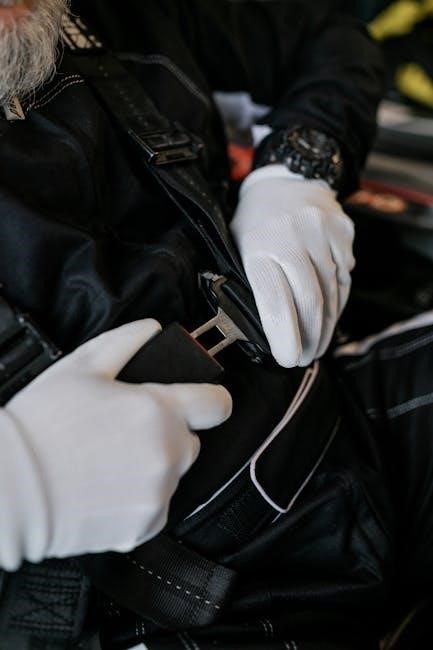

Leave a Reply
You must be logged in to post a comment.